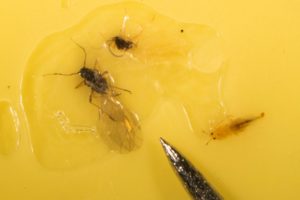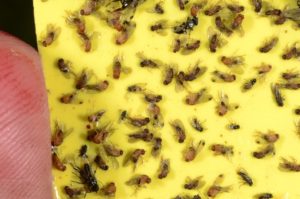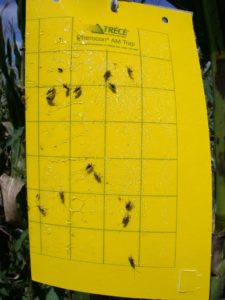While not a new technology, I thought it timely to talk about the use of yellow sticky cards as a monitoring tool. These cards will not manage insect pests in your crops, but can be a very valuable monitoring tool in high tunnels and greenhouses. Many of the insect pests that migrate into our crops move on wind currents (aphids and mites for example) or the people working in these spaces. Strategically placing sticky cards around the borders of a planting, where they can intercept wind currents, or along high traffic areas, is a great strategy for monitoring early signs of infestations.
Considerations:
- The industry has come to the consensus that yellow sticky cards are the best tool. There is no need to invest in cards with other colors.
- Some cards also contain pheromones, an added chemical to attract a particular pest. For general monitoring this is not necessary. For targeting some specific pests, they can increase the catch (apple maggot fruit fly for example).
- Consider the pest you are monitoring for in terms of placement. Most pests are detected best with a vertical placement of the card, at canopy height. If you are targeting fungus gnats, which emerge from the growing media, place them horizontally over the media.
- Look at the cards on a weekly basis, at least. The more often you check them, the more time you have to react to what you are seeing.
- Start the season with fresh cards and replace them often.
Identifying the critters that get stuck to sticky cards can be challenging. If you are ever in doubt, send the card or pictures to the Purdue Plant and Pest Diagnostic Laboratory.
To reiterate, yellow sticky cards are not a management tool, but rather a very handy monitoring tool. With frequent checking, you can detect pest infestations early, prior to observable populations or symptoms on the host plant. This can aid you in management decisions and provide time to implement biological control, which can be more effective when pest populations are low.


